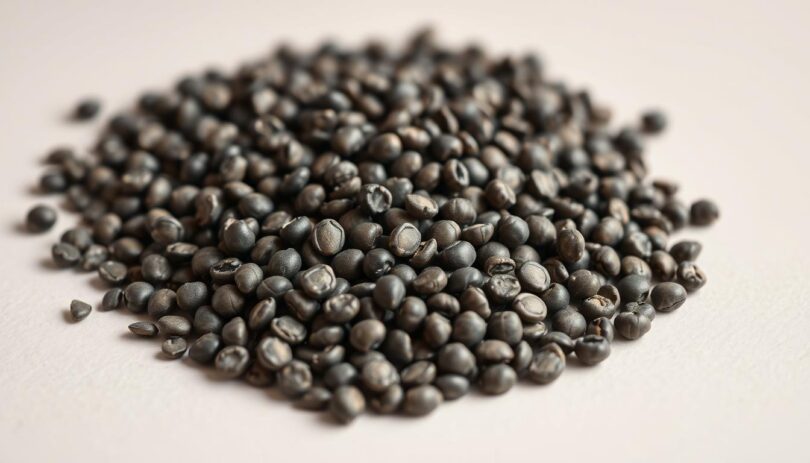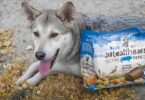What if a food celebrated as a human superfood could also transform your pet’s health—or pose unexpected risks? Tiny yet mighty, chia seeds have surged in popularity among wellness-focused households. But do these nutrient-packed specks belong in your dog’s bowl?
Once a staple of ancient Aztec and Mayan diets, these seeds now appear in modern kitchens as a plant-based source of omega-3s, fiber, and protein. Pet owners increasingly explore adding them to their furry companion’s meals for potential benefits like improved digestion or coat health.
Rich in antioxidants and minerals, these seeds seem like an ideal supplement. However, canine nutrition requires careful balance. Proper preparation and portion control matter just as much as the ingredients themselves. Overlooking these factors could turn a healthy boost into a digestive nightmare.
This article breaks down the science behind chia seeds for pets. You’ll discover how to safely incorporate them into your dog’s diet while avoiding common pitfalls. From historical roots to vet-approved guidelines, we’ll explore what every responsible pet parent needs to know.
What are Chia Seeds and Their Nutritional Profile
These tiny powerhouses trace their roots to Central America, where they fueled warriors and healers for centuries. Revered by the Aztecs as “running food,” they provided sustained energy for long journeys. Their botanical name, Salvia hispanica, hints at their medicinal heritage in traditional practices.
From Ancient Staple to Modern Superfood
Civilizations like the Maya incorporated these specks into religious ceremonies and daily meals. European colonization nearly erased their use until 20th-century researchers rediscovered their benefits. Today, they’re celebrated globally as a plant-based source of essential nutrients.
Nutrition Breakdown
Each serving packs omega-3 fatty acids rivaling salmon, plus bone-strengthening calcium. Soluble fiber forms a gel-like substance when soaked, aiding digestion. Antioxidants protect cells, while protein content supports muscle maintenance—a complete package from nature’s pantry.
Modern studies confirm what ancient cultures knew: these specks enhance meals nutritionally without altering flavors. Their versatility makes them easy to blend into various dishes, maintaining relevance across millennia as both food and functional supplement.
Can dogs eat chia seeds
Good news for pet parents: these nutrient-rich specks are non-toxic and approved by veterinary nutritionists. Organizations like Healthy Paws Pet Insurance confirm they’re safe when prepared correctly. Moderation remains key—think teaspoon-sized portions based on your companion’s weight.
Always soak dry seeds before serving. Hydrated seeds expand into a gel-like texture, reducing choking risks and easing digestion. Unprepared seeds might absorb too much moisture internally, causing discomfort.
While beneficial, these supplements shouldn’t replace balanced meals. Wag! recommends using them as occasional toppings or mixed into homemade treats. Start with small amounts to monitor tolerance.
Consult your vet before introducing new foods—especially for pets with allergies or digestive sensitivities. Upcoming sections detail creative serving ideas and breed-specific guidelines to maximize benefits safely.
Nutritional Benefits of Chia Seeds for Your Dog
Packed with essential nutrients, these tiny specks offer more than just a trendy addition to meals. When incorporated properly into a pet’s diet, they become a powerhouse for enhancing vitality from nose to tail. Research highlights their unique composition of fatty acids, plant-based compounds, and gut-friendly elements that work synergistically.
Omega-3 Fatty Acids and Antioxidant Power
The omega-3s in chia seeds support cardiovascular health and cognitive function. Studies show these fatty acids help maintain a glossy coat and reduce skin irritation. Antioxidants combat free radicals, lowering inflammation and strengthening natural defenses against illness.
One 2022 veterinary study found pets with antioxidant-rich diets had improved immune responses. This makes chia seeds particularly valuable for aging animals or those with joint discomfort.
Fiber’s Role in Digestive Wellness
Soluble fiber transforms into a gel-like substance during digestion, promoting smoother bowel movements. This process aids nutrient absorption, allowing pets to extract more energy from their food. Consistent digestion also minimizes bloating and discomfort after meals.
Proper fiber intake balances gut bacteria, which research links to better mood and energy levels. For picky eaters or pets with sensitive stomachs, this gentle fiber source can make mealtime more comfortable.
Potential Risks and Considerations for Chia Seed Consumption
While nutrient-rich additions to meals can boost wellness, improper use might lead to unintended consequences. Pet owners must balance enthusiasm with caution when introducing new elements to their companion’s routine. Understanding preparation methods and portion control ensures these supplements enhance rather than disrupt health.
Proper Serving Sizes and Soaking Techniques
Always soak chia seeds in water for 10-15 minutes before serving. Dry specks expand rapidly when ingested, potentially causing intestinal discomfort. The gel-like texture of hydrated versions moves smoothly through the digestive tract.
A general guideline suggests ¼ teaspoon per 10 pounds of body weight daily. For a 40-pound Labrador, that translates to one teaspoon mixed into meals. Exceeding this amount could lead to bloating or irregular bowel movements.
When to Consult Your Veterinarian
Schedule a checkup before adding chia seeds if your pet has diabetes or kidney issues. These conditions may require adjusted portions to avoid blood sugar spikes or mineral imbalances. Professionals can also assess interactions with existing medications.
Watch for signs like lethargy or vomiting after introducing the supplement. Immediate veterinary attention is crucial if breathing difficulties or severe diarrhea occur. Regular check-ins help tailor the diet to your companion’s evolving needs.
Remember: chia seeds complement high-quality food but shouldn’t replace balanced nutrition. Pair them with vet-approved proteins and vegetables for optimal health benefits without compromising safety.
Creative Ways to Incorporate Chia Seeds into Your Dog’s Diet
Transforming your pet’s meals into nutrient-rich experiences doesn’t require complex recipes or expensive supplements. These versatile additions blend seamlessly into everyday dishes while boosting nutritional value. Let’s explore practical methods pet owners love.
Mixing with Regular Meals
Start by stirring pre-soaked chia seeds into kibble or wet food. The gel-like texture binds ingredients while adding moisture—ideal for picky eaters. A teaspoon mixed with pumpkin puree creates a fiber-rich topping that supports digestion.
For homemade meals, blend hydrated seeds into ground turkey or vegetable stews. Their neutral taste won’t overpower familiar flavors, making transitions smoother. Always pair with high-quality proteins for balanced nutrition.
Homemade Chia-Infused Dog Treats
Combine 1 cup oat flour, ½ cup unsweetened applesauce, and 2 tablespoons soaked chia seeds. Roll dough into small balls and bake at 350°F for 15 minutes. These soft bites deliver omega-3s without artificial additives.
Freeze chia gel with blueberries or bone broth in silicone molds for cooling summer snacks. Veterinary nutrition blogs praise this method for enhancing hydration and joint health. Remember to introduce new foods gradually and watch for sensitivities.
Chia Seeds as a Supplement to a Balanced Diet
A sprinkle of superfood magic can elevate your pet’s meals from ordinary to extraordinary—when paired with proper nutrition. These nutrient-dense additions shine brightest alongside complete, vet-formulated diets rather than replacing them. Think of them as the supporting cast that amplifies the star ingredients in premium kibble or homemade recipes.
Complementary Ingredients in High-Quality Dog Food
Premium blends often combine proteins like salmon or chicken with vegetables and whole grains. Adding a teaspoon of soaked chia seeds introduces plant-based omega-3s that work synergistically with animal-sourced nutrients. This combination enhances nutrient absorption while maintaining calorie control.
Veterinary nutritionists recommend pairing these supplements with antioxidant-rich foods like blueberries or spinach. The soluble fiber content aids digestion of dense proteins, creating a balanced gut environment. Always measure portions to avoid displacing essential nutrients from primary food sources.
Enhancing Coat, Digestion, and Energy Levels
Regular inclusion of chia in meals supports glossy fur through fatty acids that nourish skin cells from within. A 2023 study showed pets consuming omega-rich supplements had 30% less shedding compared to control groups. The gradual energy release from fiber and protein also stabilizes activity levels throughout the day.
For sensitive stomachs, the gel-like texture of hydrated seeds soothes intestinal linings while promoting regularity. Many owners report improved stool quality within two weeks of controlled supplementation. Always consult your vet to tailor amounts based on your companion’s unique needs and existing diet quality.
Tailoring Chia Seed Intake for Different Dog Breeds and Sizes
Just like humans, every pet has unique nutritional needs shaped by their body structure and genetic makeup. Customizing portions ensures these nutrient-rich additions support wellness without overwhelming delicate systems. Let’s explore how to adjust servings for companions ranging from teacup pups to gentle giants.
Weight-Based Measurement Rules
A standard guideline suggests ¼ teaspoon per 10 pounds of body weight daily. For a 5-pound Yorkie, this translates to ⅛ teaspoon. A 50-pound Golden Retriever would receive 1¼ teaspoons. Always use soaked seeds to prevent internal expansion issues.
Breed Metabolism and Energy Demands
High-energy breeds like Border Collies may benefit from slightly increased amounts during active seasons. Conversely, low-metabolism breeds such as Bulldogs often thrive with smaller portions. Giant breeds like Mastiffs require careful monitoring to avoid excessive calorie intake.
Small breeds under 20 pounds need gradual introductions to prevent digestive upset. Medium-sized companions (20-60 pounds) typically adapt well to standard measurements. For pets with health conditions like diabetes, consult your vet before adjusting their diet.
Track your companion’s energy levels and stool consistency after introducing this supplement. Reduce servings if loose stools occur. Pair these adjustments with high-quality proteins and vegetables for balanced nutrition that complements their lifestyle.
Always discuss dietary changes with a veterinary professional. They can help create a personalized plan considering age, activity level, and breed-specific requirements.
Final Thoughts on Integrating Chia Seeds into Your Dog’s Wellness Routine
Navigating pet nutrition trends requires balancing potential rewards with practical wisdom. When introduced properly, chia seeds offer a natural boost to your companion’s diet. Research confirms their value in supporting coat quality, digestive regularity, and sustained energy through omega-3s and soluble fiber.
Hydration remains critical—always soak these supplements to prevent gastrointestinal issues. Stick to measured portions based on your pet’s weight, blending them into meals or homemade snacks. Pairing them with high-quality proteins and vegetables creates balanced nourishment.
Regular vet check-ins help tailor this addition to individual health needs. Observe your furry friend’s response, adjusting as needed. Though not a cure-all, these nutrient-packed seeds can enhance wellness routines when used thoughtfully.
Informed choices transform trendy ingredients into lasting benefits. By prioritizing preparation and moderation, pet parents unlock nature’s potential while safeguarding their companion’s vitality.
FAQ
Are chia seeds safe for all breeds?
Most breeds tolerate chia seeds well when introduced gradually. Small dogs (under 20 lbs) should start with ¼ teaspoon daily, while larger breeds can handle up to 1 tablespoon. Always monitor for digestive changes and consult your vet for breed-specific advice.
How do chia seeds support skin and coat health?
The omega-3 fatty acids in these superfoods reduce inflammation and promote a glossy coat. Antioxidants like quercetin further protect skin cells, making them ideal for pets with dryness or seasonal allergies.
Can chia help manage a pet’s weight?
Their high soluble fiber content creates a gel-like substance in the stomach, promoting satiety. This helps curb overeating while providing essential nutrients—useful for weight management plans when paired with exercise.










Leave a Comment